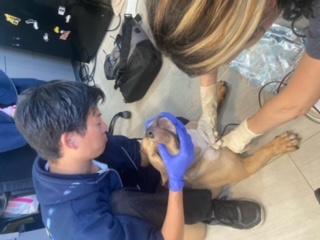Calif. inches toward ending closed-colony animal blood banks
 Listen to this story.
Listen to this story.
Pancake blood draw

Photo by Dr. Kim Tong
As veterinary technician Christina Furr, right, drew blood from Pancake at Lenity Vet Specialists and Emergency Care in Northern California, the dog started to doze off in the hands of veterinary assistant Yasuo Maehata. Lenity is home to Brave Unity Blood Bank, the first commercial community blood bank in the state, although Pancake's blood was for in-house use, not sale.
California is taking steps toward changing which dogs and cats are eligible to give blood at veterinary blood banks in the state, but it remains years away from its twin goals of alleviating shortages in the supply of animal blood and ending the use of captive colonies.
Historically, the state was unique in the U.S. in requiring that purchased cat and dog blood be obtained from animals that live in closed colonies, where they are bled every couple of weeks. Supporters of the closed-colony model say it ensures a reliable blood supply free from disease. Opponents consider it to be inhumane and archaic.
A law that went into effect in January 2022 permitted veterinarians licensed in California to open animal blood banks using blood drawn from pets living in the community. California pet owners are now able to provide their animals for blood draws, usually in exchange for services, such as health screenings and examinations. Most commercial blood banks around the country similarly rely on pet-owner volunteer programs.
In California, there are two closed-colony operations: Hemopet, a nonprofit near Santa Ana that sells canine blood, and Animal Blood Bank Inc. (also doing business as Animal Blood Resources International), a for-profit in Dixon that sells canine and feline blood.
The California Department of Food and Agriculture (CDFA) will discontinue licensing these banks within 18 months of making a finding that community blood banks sold more canine blood and blood component products, such as frozen plasma and red blood cells, than closed-colony operations for four consecutive quarters.
Such a finding could be a long way off.
In the nearly two years since the law went into effect, 39 community blood banks have registered with the California Veterinary Medical Board (CVMB) to obtain a blood bank premises permit. Nearly all, however, are only collecting blood for use in their own patients.
As of Sept. 5, only Brave Unity Blood Bank for Animals in San Mateo had registered products with the CDFA, which is required of any establishment that intends to sell animal blood and/or its components. Approval is pending for two blood products from a second blood bank, which could be registered as soon as this week, according to Dr. Sean Brady, who began managing the animal blood bank program for the CDFA in June 2022.
The closed-colony operations, Hemopet and Animal Blood Bank, together sold more than 2.8 million milliliters of blood in 2022 and the first two quarters of 2023, according to CDFA reports. Brave Unity, the sole community blood bank registered to sell products, began collecting blood in early October and has not sold any blood to date.
The new law divides oversight of blood banking in California between the CVMB and CDFA. The veterinary medical board is responsible for enforcing regulations regarding blood banking premises, processes and facilities. The CDFA is responsible for ensuring the effectiveness and safety of commercial blood products.
Leading the way
Brave Unity owner Dr. Kimberly Carlson said that as soon as she heard California might change its rules around blood banking, she wanted to participate. A surgeon and the owner of Lenity Vet Specialists and Emergency Care in the San Francisco Bay Area, Carlson was spurred by an aversion to the closed-colony approach, whereby animals, she said, "live just to donate blood." She also was motivated by her first-hand experience of blood shortages.
"Currently, the wait time for blood from the closed-colony blood banks is 24 weeks, and invariably you buy blood, and it expires," she said. "You've paid for this expensive bag of blood, and you just lost all that money."
Hemopet told the VIN News Service its wait list is currently about nine weeks. VIN News was not able to ascertain wait times at Animal Blood Bank.
Carlson said the process of establishing the blood bank and passing the state inspection was intensive and time-consuming. Recruiting volunteers is an additional challenge, partly due to California's restrictions on offering incentives for donations, Carlson said.
"You have to be really creative about how you can reward the pet owner without it being interpreted as compensating them for their pets' blood, because you cannot compensate them," she explained.
Carlson considers some of the restrictions to be impractical. "After we had all these bandanas printed for cats and dogs that say, 'I'm a life-saving hero' on them, we found out that you can't send a blood donor home with a bandana on it," she said. "If they are wearing a bandana, it has to be a bandana that any dog in the hospital would be able to wear.
"It makes you wonder, 'Does the state of California really want to eliminate these closed-donor blood banks?' because they are making it really difficult for anybody to really want to take on this project and get blood donors."
The state Business and Professions Code specifies that blood banks "shall not provide payment to a person who provides an animal for the purpose of donating that animal's blood"; and "payment" can include the transfer of a "valuable consideration that can be converted to money by the recipient" but excludes fees for veterinary tests, medications, vaccinations and screenings.
At present, Brave Unity is sourcing blood donations from the pets of owners who are friends and family of Lenity Vet staff.
National picture
Outside of California, there are a handful of national and regional commercial blood banks. In addition, many veterinary school teaching hospitals have blood banks to serve their patients. Numerous specialty and emergency hospitals and several corporate specialty groups — including BluePearl Specialty and Emergency Pet Hospital, Ethos Veterinary Health, Thrive Pet Healthcare and VCA — operate blood banks for their patients.
Veterinary Emergency Group, which has more than 60 hospitals around the country, announced in September that it would set up a blood banking operation to support its hospitals. "However, at VEG our goal is to say 'yes,' " the company said by email. "So, if a hospital in the area of a VEG has a patient in need and we have blood product available, we can sell it at a comparable price."
Blood shortages are not unique to California and its closed-colony model. Across the U.S., there are long waits for animal blood products. Waits are anywhere from eight to 20 weeks for red blood cells, according to VEG.
Demand for blood has ballooned in recent years, according to Dr. Anne Hale, an expert in hematology and transfusion medicine, and medical director of Zia Veterinary Regenerative Partners in New Mexico.
"Because of the advancement of critical care and emergency medicine and oncology, there are a lot of reasons why dogs and cats need blood products. And the need just grows 10 times over, all the time," said Hale, who started one of the earliest national animal blood banks, Midwest Animal Blood Services in Michigan. It merged with Animal Blood Bank in California in 2008.
Shortages worsened during the Covid-19 pandemic, Hale said, because bringing donor dogs into hospitals was curtailed. "Just like on the human side, volunteer blood banking was very difficult to practice because we were staying six feet apart from each other, and nobody wanted to come into town."
Hale noted that donor traffic has improved now that clinics are "seeing patients actively in the old style." But she added, "We have not regained where we were."
Limited blood supplies can have serious consequencees for animals.
"On the human side of things, transfusion medicine is practiced based on patient need," she said. "In veterinary medicine, because of the lack of donors that are available … it's really what's available that decides whether or not a dog is going to get treated. That's a big problem."